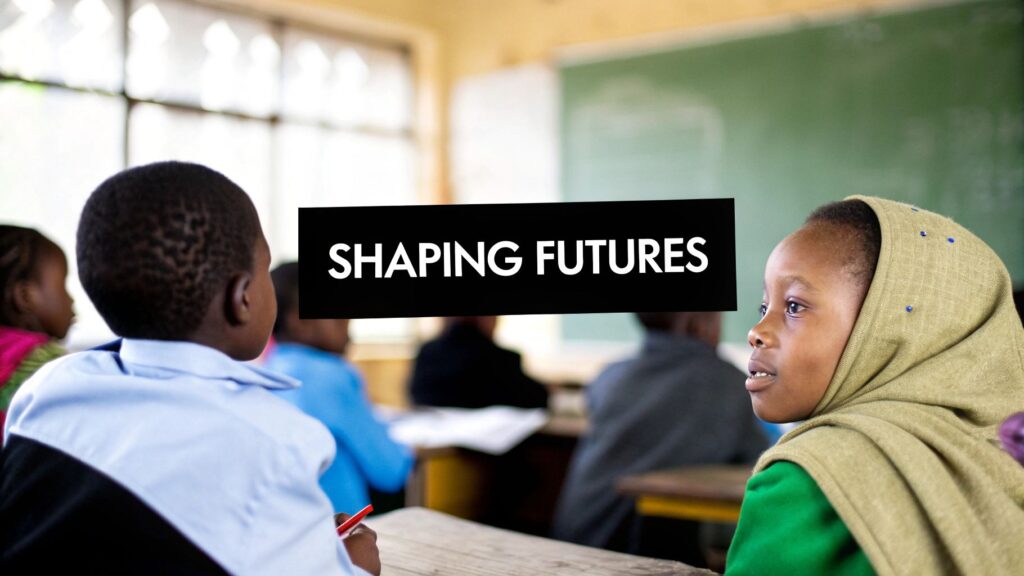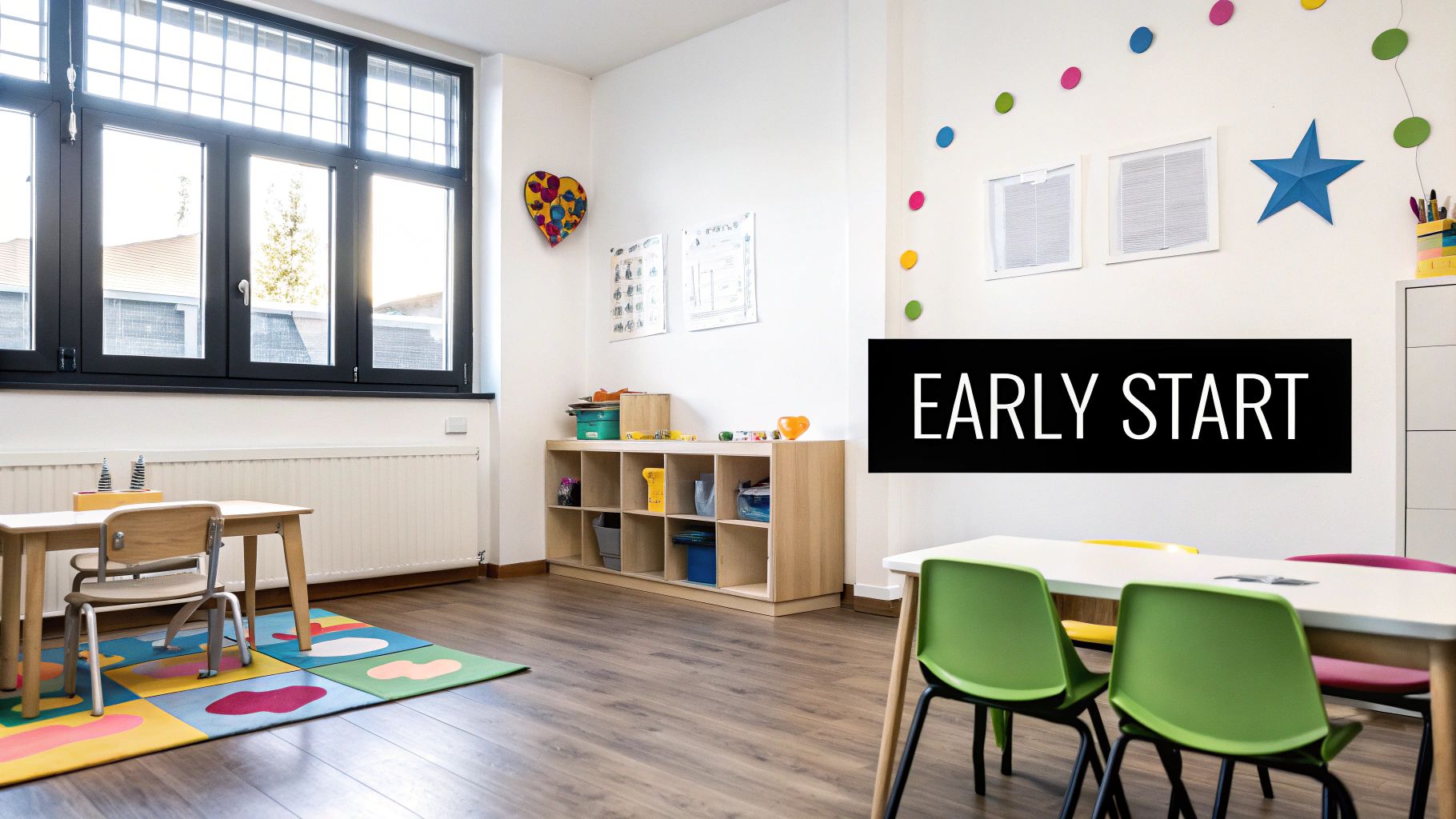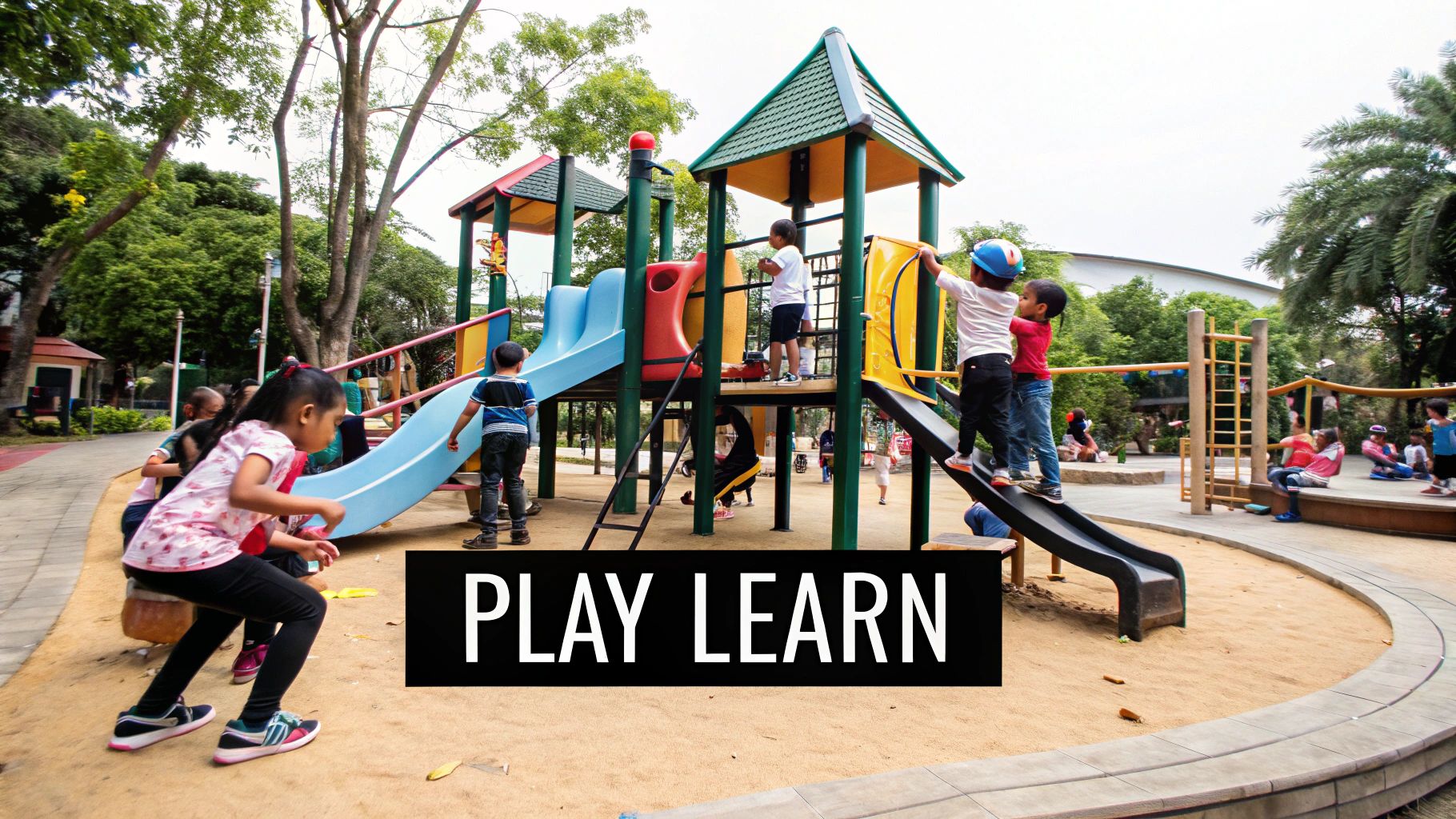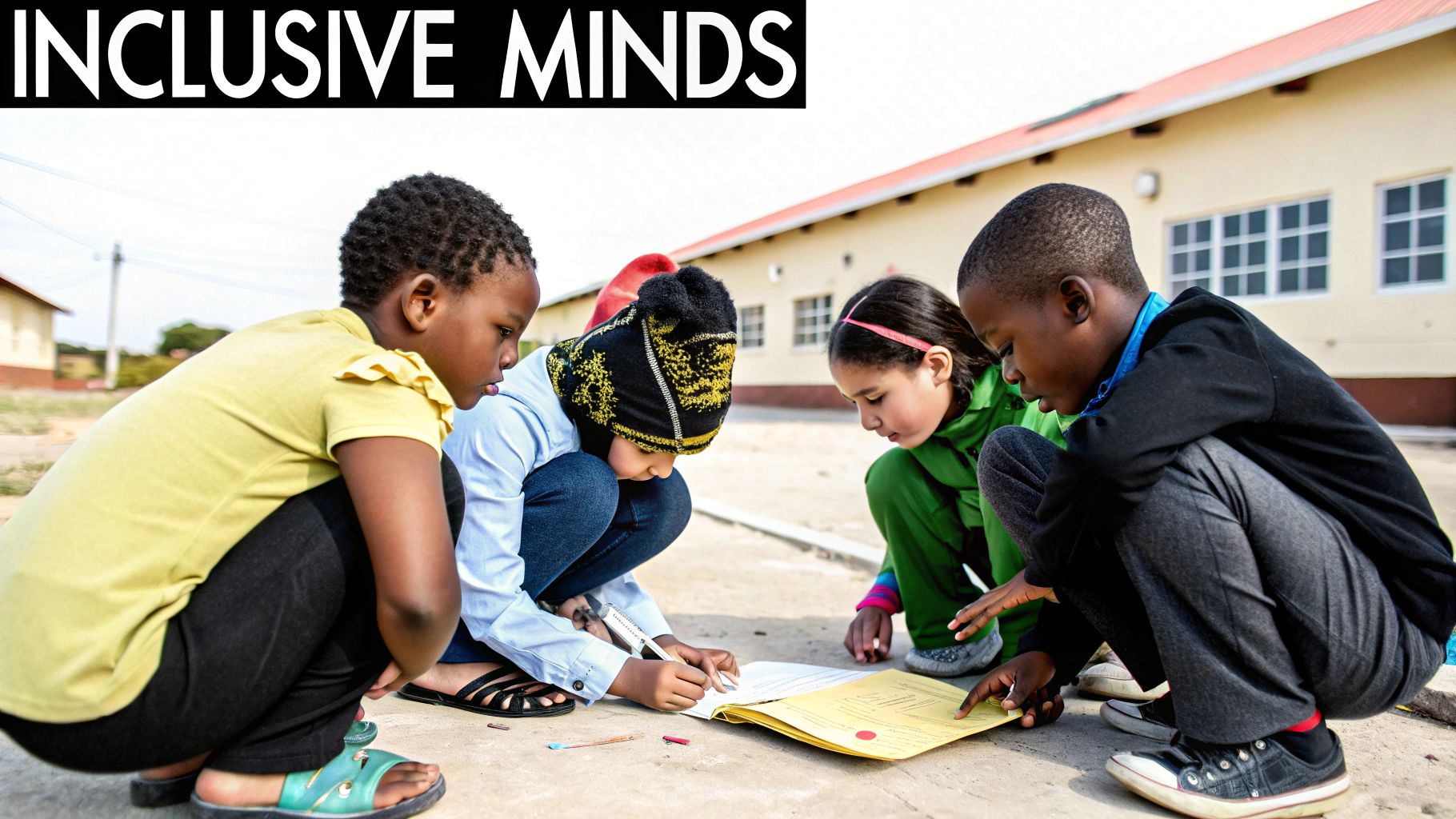
Shaping Africa’s Future: Early Childhood Education
The Current Reality of Early Childhood Education in Africa

Access to quality early childhood education (ECE) in Africa presents a varied picture, marked by significant inequalities across the continent. This situation directly impacts the future of millions of children, influencing their cognitive, social, and emotional growth. A clear understanding of these current circumstances is essential for creating effective solutions and building a stronger foundation for future generations.
Access and Enrollment: Unequal Opportunities
One of the most significant challenges is the unequal distribution of access to pre-primary education. While some countries have shown considerable progress, others are significantly behind. This disparity creates a stark contrast in the opportunities available to children in different regions.
For instance, Mauritius has a gross enrollment rate in pre-primary education approaching 100%. However, this is an exception. Many other African nations struggle with significantly lower enrollment, often less than 40%. This gap highlights the urgent need for focused actions to ensure more equitable access to ECE across the continent.
This disparity isn't just about statistics; it translates into real-world consequences for children. Six countries, including Burkina Faso, Chad, Côte d'Ivoire, the Democratic Republic of the Congo, Mali, and Niger, have enrollment rates below 10%. This means most children in these nations are missing out on the critical foundational learning offered by pre-primary education. Early childhood education in Africa faces substantial obstacles, especially concerning access and quality. For more detailed statistics, see: Learn More. This uneven distribution demands focused efforts to broaden access and ensure every child has the chance to benefit from early learning.
Quality and Its Impact: More Than Just Attendance
Simply increasing enrollment isn't sufficient. The quality of early childhood education programs is equally important. Factors such as teacher training, curriculum development, and access to learning resources are crucial for effective ECE.
In many areas, under-resourced programs, inadequate teacher training, and a shortage of appropriate learning materials limit the potential advantages of early learning. This directly impacts children's development and their readiness for primary school.
Health and Education: A Holistic Approach
Health challenges also present a significant barrier to effective early childhood education in Africa. Issues such as malnutrition and anemia directly impact children's cognitive and psychomotor development.
Malnourished children often experience developmental delays, affecting their ability to learn and flourish in educational settings. Addressing these health problems is crucial for creating an environment where children can fully engage with and benefit from early learning programs.
This requires a comprehensive strategy that integrates health and education interventions to support the overall well-being of young children. Tackling these interconnected challenges will require collaborative efforts between governments, NGOs, and communities to ensure every child can reach their full potential.
Breaking Cycles: Why Early Childhood Education Matters

Early childhood education (ECE) is more than just preparation for primary school. It's a crucial foundation for individual and societal growth. During this period of rapid brain development, neural connections form at an incredible pace, shaping future learning, social skills, and emotional well-being. Quality early learning experiences have a significant impact on a child's life trajectory.
Building Strong Foundations: The Impact of Early Learning
Early childhood education gives children the fundamental building blocks they need for academic success. It equips them with pre-literacy and pre-numeracy skills, encourages language development, and nurtures a love of learning. This ensures children enter primary school better prepared with a solid foundation for future learning.
ECE also plays a vital role in social-emotional development. In a supportive environment, children learn to interact with peers, regulate their emotions, and develop crucial problem-solving skills. These skills are not only essential for academic achievement, but also for navigating the challenges of life.
The Continental Education Strategy for Africa: A Focus on ECE
The potential of early childhood education to break intergenerational cycles of inequality highlights its importance in Africa. The Continental Education Strategy for Africa (CESA 16-25) recognizes ECE as a critical area for quality education. However, the sector faces significant obstacles, including inadequate planning, limited resources, insufficiently trained teachers, and a lack of learning materials. These challenges disproportionately affect children in rural and underserved communities where preschools are often scarce. Learn more about the challenges and opportunities of ECE in Africa here.
Investing in the Future: Long-Term Benefits of ECE
Investing in early childhood education is not merely addressing immediate needs; it's a long-term investment with significant returns. Studies show that children who participate in quality ECE programs have a higher likelihood of graduating high school, attending college, and earning higher incomes as adults. They also experience lower rates of incarceration and reduced dependence on social welfare programs. This demonstrates that ECE not only benefits individuals but also positively impacts communities and society as a whole.
You might be interested in exploring additional educational resources on our sitemap. Early childhood education initiatives across the AE region demonstrate a growing awareness of its importance. For example, the UAE's focus on expanding access to quality preschool programs reflects a commitment to building a strong educational foundation for every child. This commitment is visible in the growth of both public and private preschools, alongside initiatives to enhance teacher training and curriculum development. These efforts are vital for building a future where all children have the opportunity to flourish.
Beyond the Gender Gap: Creating Equitable Foundations

Early childhood education is the foundation for future success. Ensuring equitable access for both boys and girls is critical. However, gender disparities often appear during these formative years, impacting children long-term. This section explores the root causes of these disparities and highlights effective interventions within the AE region.
Understanding the Roots of Inequality
Cultural norms, economic pressures, and systemic biases contribute to gender inequality in early childhood education. Traditional gender roles can restrict girls' access to education in some communities. In others, economic hardship may compel families to prioritize boys' education. These often deeply ingrained biases shape opportunities from the very beginning.
For example, some families believe girls should prioritize domestic skills over academics. This can exclude girls from early learning programs, impacting their cognitive development and future opportunities. These beliefs often prevent girls from experiencing enriching learning environments essential for early development.
Systemic biases within educational systems can also worsen inequalities. A shortage of female teachers, gender-stereotyped learning materials, and unequal resource allocation can disadvantage girls. These systemic barriers reinforce societal biases.
In sub-Saharan Africa, education exclusion is widespread. Over one-fifth of children aged 6-11 are out of school, increasing to almost 60% for 15-17-year-olds. Girls' education is disproportionately affected, with 9 million girls aged 6-11 never attending school compared to 6 million boys. Learn more from the UNESCO Institute for Statistics. This data underscores the need for interventions to close the gender gap, especially in early childhood.
Addressing Gender Barriers in Early Childhood Education
Recognizing these complex challenges, numerous programs in the AE region aim to improve girls' early education. Initiatives include scholarships for girls, building schools in underserved communities, and training female teachers. These efforts are creating more inclusive and equitable learning environments.
For example, some UAE programs offer free or subsidized early childhood education for girls from low-income families. Other programs train female educators within their communities to create culturally relevant learning experiences. These initiatives have significantly increased girls' enrollment in early learning centers.
Creating a Brighter Future Through Equitable Early Childhood Education
Targeted early childhood education interventions have far-reaching impacts beyond the classroom. These positive ripple effects include changing family attitudes, transforming community expectations, and creating new economic opportunities. These changes benefit individuals, families, and society.
This focus on gender equity has broader societal advantages. Educated girls are more likely to delay marriage and childbirth, raise healthier families, and contribute to economic growth. Investing in girls' early education is an investment in a brighter future for all. The ongoing efforts to provide quality early childhood education to every child in the AE region, regardless of gender, are crucial for a more equitable and prosperous future.
Innovative Early Childhood Education Models That Work

Resource limitations can often lead to incredible ingenuity. This is especially evident in early childhood education (ECE) across the AE region, where educators are developing resourceful and effective approaches to providing quality learning. These approaches demonstrate that strong early education can thrive even in challenging environments, expanding access to quality ECE in under-resourced communities.
Community-Driven Initiatives: Parents as Educators
One impactful model focuses on empowering parents as educators. Parents are often a child's first and most important teachers. By offering training and resources, these programs equip parents with the skills they need to nurture their children's early learning at home. This approach strengthens the vital connection between home and school, creating a supportive learning environment.
For example, programs in the UAE train mothers to lead early literacy activities using readily available materials. These initiatives not only boost children's learning but also empower mothers within their own communities. This parent-led model is especially valuable in remote or underserved areas where access to formal preschools may be limited.
Mobile Learning Programs: Reaching Remote Areas
Mobile learning programs are another impactful innovation. These programs deliver educational resources directly to children in remote or nomadic communities. This model overcomes geographical barriers and ensures that children in isolated locations can access quality early learning.
Specially outfitted buses or vans, stocked with learning materials and technology, travel to various locations. Trained educators facilitate structured learning activities within these mobile classrooms. This approach can significantly impact children's early development, especially in areas where establishing traditional preschools is difficult.
Public-Private Partnerships: Sustainable Funding
Sustainable funding is essential for any successful ECE program. Public-private partnerships (PPPs) provide a promising solution, combining government funding with private investment. This collaborative model promotes long-term financial stability and supports the growth of quality ECE programs.
For example, some AE governments are partnering with private companies to construct and operate new preschools, especially in rapidly developing areas. These PPPs utilize the expertise and resources of both sectors, creating positive outcomes for children and families. This collaboration often results in more innovative and effective early childhood education programs. You might be interested in: Our list of helpful resources.
Blending Technology, Tradition, and Modern Pedagogy
Effective ECE models in the AE region often blend technology with traditional knowledge and modern teaching methods. This integrated approach creates culturally relevant learning experiences that resonate with both children and their communities.
For instance, some programs incorporate digital storytelling on tablets, featuring local folktales and cultural traditions. This allows children to connect with their heritage while developing important digital literacy skills. This combined approach not only enhances engagement but also preserves and celebrates the richness of local cultures.
To better understand the diversity of these programs, let's take a closer look at some specific examples.
Introducing the following table which outlines various successful early childhood education approaches across Africa:
"Innovative Early Childhood Education Models in Africa"
This table compares different successful early childhood education approaches across the continent, highlighting their unique features, implementation contexts, and outcomes.
| Model Type | Key Features | Countries Implemented | Challenges | Success Indicators |
|---|---|---|---|---|
| Parent-led Early Learning Programs | Focus on training parents/caregivers to facilitate learning activities at home using readily available materials | Uganda, Kenya, Ghana | Ensuring consistent quality of parent training, reaching remote communities | Improved early literacy and numeracy skills, increased parental involvement in education |
| Mobile Preschools | Buses or vans equipped as classrooms bring education to remote areas | Botswana, Namibia, South Africa | Logistical challenges (road conditions, maintenance), teacher recruitment and retention in remote areas | Increased access to early childhood education in underserved communities, improved school readiness |
| Community-based Early Childhood Development Centers | Utilize existing community structures (churches, community halls) to establish low-cost preschools | Senegal, Mali, Burkina Faso | Ensuring adequate infrastructure and resources, training local facilitators | Increased enrollment in early childhood education, community ownership and sustainability of programs |
| Integrating Technology in Early Learning | Use of tablets, educational apps, and digital resources to enhance learning experiences | Rwanda, Kenya, Nigeria | Access to electricity and internet connectivity, teacher training on technology integration | Improved learning outcomes, development of 21st-century skills |
This table offers a glimpse into the diverse and innovative ECE models being implemented across Africa. These models, while facing various challenges, demonstrate significant successes in improving access to quality early learning and promoting positive child development outcomes.
These diverse models showcase the power of innovation in early childhood education throughout the AE region. They offer valuable lessons and inspiration for enhancing early learning opportunities for all children. Each model emphasizes successful principles, effective strategies, and honest evaluations of the challenges encountered. These learnings can be adapted to different situations to create more effective and sustainable ECE programs.
Empowering Educators: Training That Transforms
The success of any early childhood education (ECE) program relies heavily on the educators themselves. Even the most well-designed curriculum won't be effective without skilled and supported teachers to implement it. This section explores the vital role of educator training in the AE region, highlighting both the challenges and advancements in cultivating a qualified workforce.
Equipping Educators for Success: Practical Training in Resource-Constrained Environments
Effective ECE training needs to provide educators with practical skills applicable in various learning environments. Resource constraints are a reality in many AE countries, necessitating creative and adaptable teaching strategies. Training programs must acknowledge these limitations, equipping educators with tools and techniques that can thrive within them.
For instance, some programs teach educators how to create engaging learning materials from readily available resources, promoting resourcefulness and creativity. This practical approach ensures teachers can effectively deliver the curriculum irrespective of resource limitations.
Building Support Networks: Mentorship and Ongoing Professional Development
Continuous support and professional development beyond initial training are essential to prevent teacher burnout and foster a sense of community. Mentorship programs connect experienced educators with newcomers, offering guidance and support. These networks create a valuable platform for sharing best practices, addressing challenges, and promoting continuous improvement in teaching.
These mentoring relationships provide individualized support, helping new teachers navigate the complexities of the profession. This support is particularly important in the AE region, where rapid educational growth demands a strong and dedicated workforce.
Attracting and Retaining Talent: Fair Compensation and Career Pathways
Attracting and retaining qualified educators requires addressing systemic issues like compensation, professional recognition, and career advancement. Appropriate compensation recognizes the valuable contributions of educators and ensures their financial security. Providing clear career pathways offers opportunities for growth and encourages teachers to pursue professional development. Learn more in our article about how to master SEO. These incentives are vital for building a sustainable and flourishing ECE workforce.
The UAE, for example, has introduced initiatives to raise teacher salaries and provide ongoing professional development opportunities. This commitment to valuing educators positively impacts teacher morale, retention, and the overall quality of early childhood education.
Transforming Educational Communities: The Impact of Quality Training
Quality training goes beyond improving individual teaching practices; it transforms entire educational communities. When teachers feel supported and empowered, they create richer and more effective learning environments for children. This positive effect extends outwards, benefiting families, communities, and future generations.
The Path Forward: Early Childhood Education in Africa
Early childhood education (ECE) in Africa is at a crucial point. The next ten years will bring significant changes in how we approach ECE. These changes will be driven by shifting demographics, economic realities, and technological advancements. This section explores emerging trends and innovations shaping the future of early childhood education across the continent, with a focus on the African region.
Emerging Trends and Innovations
Several key trends are set to reshape ECE in Africa:
-
Focus on Indigenous Knowledge: There's a growing movement to integrate indigenous knowledge systems into modern teaching methods. This recognizes the value of local knowledge and cultural contexts. These factors help create relevant learning experiences for children. For example, some preschools in the UAE are now incorporating traditional storytelling and cultural practices into their curriculums.
-
Technological Integration: Technology is becoming increasingly important in ECE. Mobile learning platforms are now able to reach remote communities. Digital learning resources are enriching classroom experiences. This integration offers personalized learning opportunities. It also expands access to quality ECE resources.
-
Parent Advocacy and Engagement: Parental involvement is vital for successful ECE. Across Africa, parent advocacy groups are pushing for greater investment in early learning. This engagement strengthens the connection between home and school. This creates a more supportive learning environment.
-
Cross-Sector Collaboration: Effective ECE requires collaborative efforts. Partnerships between governments, NGOs, private sector organizations, and communities are becoming more common. These partnerships use resources and expertise from different sectors. This results in more impactful and sustainable programs.
Addressing Challenges and Fostering Growth
While these trends offer promising directions, challenges still exist:
-
Funding and Resource Allocation: Adequate funding remains a major hurdle. Innovative financing models, such as public-private partnerships, are crucial for sustainable investment in ECE. This also includes exploring options like blended financing and securing greater commitments from national budgets.
-
Teacher Training and Development: A well-trained workforce is essential for quality ECE. Ongoing professional development and mentorship programs are vital. These programs help support teachers and give them the skills they need to deliver effective instruction. This requires creating clear career pathways and offering professional growth opportunities within the ECE sector.
-
Reaching Marginalized Communities: Equitable access to ECE is essential. Targeted interventions are needed to reach marginalized communities. These communities include children with disabilities, children in remote areas, and children from low-income families. Interventions may involve mobile learning programs, community-based ECE centers, and scholarships.
Early Childhood Education Statistics Across African Regions
To better understand the current state of ECE in Africa, the following table provides a snapshot of key metrics across different regions. It highlights both the challenges faced and the progress made.
Early Childhood Education Statistics Across African Regions
| Region | Enrollment Rate | Teacher-Student Ratio | Annual Investment | Key Challenges | Notable Improvements |
|---|---|---|---|---|---|
| East Africa | 35% | 1:40 | $50 per child | Limited infrastructure, teacher shortages | Increased community-based programs, improved teacher training initiatives in some countries |
| West Africa | 25% | 1:50 | $30 per child | Low enrollment rates, inadequate funding | Growing focus on parent-led programs, pilot projects using technology to enhance learning |
| North Africa | 45% | 1:30 | $75 per child | Disparities between urban and rural areas, curriculum development | Higher enrollment rates compared to other regions, government initiatives to expand access |
| Southern Africa | 55% | 1:35 | $60 per child | Access in remote areas, quality of teacher training | Strong focus on inclusive education, increased investment in ECE infrastructure |
| Central Africa | 15% | 1:60 | $20 per child | Low enrollment, conflict and instability in some countries | Humanitarian aid supporting ECE programs, community mobilization efforts to increase access |
These statistics show a varied picture of ECE across the continent. Some regions are making good progress, while others face significant obstacles. Solutions tailored to each region's specific needs are crucial for real and lasting improvement.
The future of early childhood education in Africa depends on collaborative efforts. By investing in quality programs, supporting educators, and addressing systemic inequalities, we can help every child reach their full potential. This will help build a brighter future for the continent. Are you ready to make a difference in education? Explore the courses offered by the National Academy. They offer a diverse range of programs designed to enhance skills and knowledge in various fields, from education to finance and fashion.